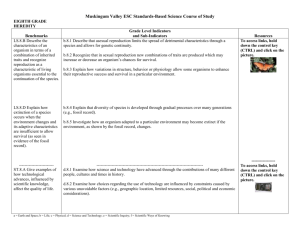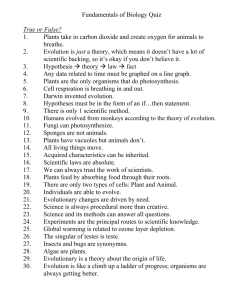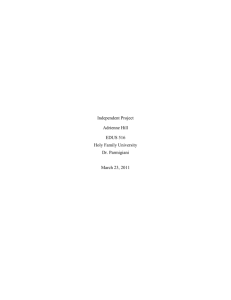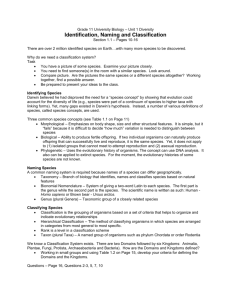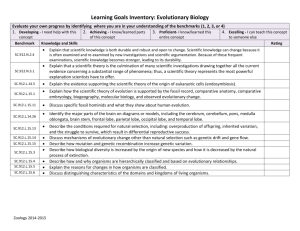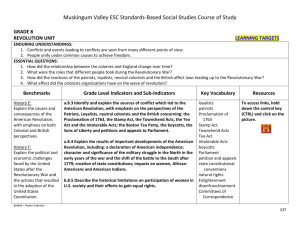Evolution
advertisement
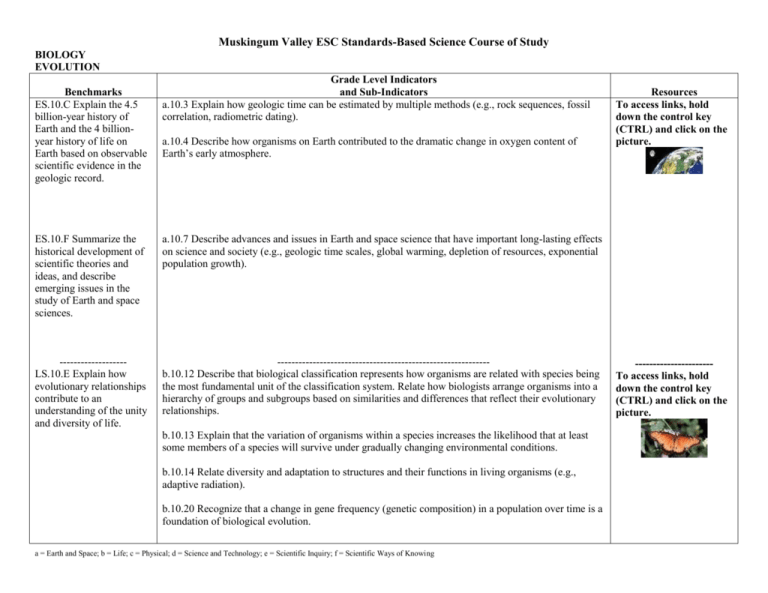
Muskingum Valley ESC Standards-Based Science Course of Study BIOLOGY EVOLUTION Benchmarks ES.10.C Explain the 4.5 billion-year history of Earth and the 4 billionyear history of life on Earth based on observable scientific evidence in the geologic record. Grade Level Indicators and Sub-Indicators a.10.3 Explain how geologic time can be estimated by multiple methods (e.g., rock sequences, fossil correlation, radiometric dating). a.10.4 Describe how organisms on Earth contributed to the dramatic change in oxygen content of Earth’s early atmosphere. ES.10.F Summarize the historical development of scientific theories and ideas, and describe emerging issues in the study of Earth and space sciences. a.10.7 Describe advances and issues in Earth and space science that have important long-lasting effects on science and society (e.g., geologic time scales, global warming, depletion of resources, exponential population growth). ------------------LS.10.E Explain how evolutionary relationships contribute to an understanding of the unity and diversity of life. -----------------------------------------------------------b.10.12 Describe that biological classification represents how organisms are related with species being the most fundamental unit of the classification system. Relate how biologists arrange organisms into a hierarchy of groups and subgroups based on similarities and differences that reflect their evolutionary relationships. b.10.13 Explain that the variation of organisms within a species increases the likelihood that at least some members of a species will survive under gradually changing environmental conditions. b.10.14 Relate diversity and adaptation to structures and their functions in living organisms (e.g., adaptive radiation). b.10.20 Recognize that a change in gene frequency (genetic composition) in a population over time is a foundation of biological evolution. a = Earth and Space; b = Life; c = Physical; d = Science and Technology; e = Scientific Inquiry; f = Scientific Ways of Knowing Resources To access links, hold down the control key (CTRL) and click on the picture. ---------------------To access links, hold down the control key (CTRL) and click on the picture. Muskingum Valley ESC Standards-Based Science Course of Study LS.10.H Describe a foundation of biological evolution as the change in gene frequency of a population over time. Explain the historical and current scientific developments, mechanisms and processes of biological evolution. b.10.21 Explain that natural selection provides the following mechanism for evolution; undirected variation in inherited characteristics exist within every species. These characteristics may give individuals an advantage or disadvantage compared to others in surviving and reproducing. The advantaged offspring are more likely to survive and reproduce. Therefore, the proportion of individuals that have advantageous characteristics will increase. When an environment changes, the survival value of some inherited characteristics may change. LS.10.I Explain how natural selection and other evolutionary mechanisms account for the unity and diversity of past and present life forms. b.10.24 Analyze how natural selection and other evolutionary mechanisms (e.g., genetic drift, immigration, emigration, mutation) and their consequences provide a scientific explanation for the diversity and unity of past life forms, as depicted in the fossil record, and present life forms. LS.10.J Summarize the historical development of scientific theories and ideas, and describe emerging issues in the study of life sciences. b.10.26 Use historical examples to explain how new ideas are limited by the context in which they are conceived. These ideas are often rejected by the scientific establishment; sometimes spring from unexpected findings; and usually grow slowly through contributions from many different investigators (e.g., biological evolution, germ theory, biotechnology, discovering germs). b.10.22 Describe historical scientific developments that occurred in evolutionary thought (e.g., Lamarck and Darwin, Mendelian Genetics and modern synthesis). b.10.25 Explain that life on Earth is thought to have begun as simple, one celled organisms approximately 4 billion years ago. During most of the history of Earth only single celled microorganisms existed, but once cells with nuclei developed about a billion years ago, increasingly complex multicellular organisms evolved. b.10.27 Describe advances in life sciences that have important long-lasting effects on science and society (e.g., biological evolution, germ theory, biotechnology, discovering germs). a = Earth and Space; b = Life; c = Physical; d = Science and Technology; e = Scientific Inquiry; f = Scientific Ways of Knowing Muskingum Valley ESC Standards-Based Science Course of Study ST.10.B Explain that science and technology are interdependent; each drives the other. d.10.2 Describe examples of scientific advances and emerging technologies and how they may impact society. To access links, hold down the control key (CTRL) and click on the picture. -----------------SI.10.A Participate in and apply the processes of scientific investigation to create models and to design, conduct, evaluate and communicate the results of these investigations. --------------------------------------------------------------e.10.1 Research and apply appropriate safety precautions when designing and conducting scientific investigations (e.g., OSHA, MSDS, eyewash, goggles, ventilation). -------------------To access links, hold down the control key (CTRL) and click on the picture. e.10.2 Present scientific findings using clear language, accurate data, appropriate graphs, tables, maps and available technology. e.10.3 Use mathematical models to predict and analyze natural phenomena. e.10.4 Draw conclusions from inquiries based on scientific knowledge and principles, the use of logic and evidence (data) from investigations. e.10.5 Explain how new scientific data can cause any existing scientific explanation to be supported, revised or rejected. -----------------------SK.10.A Explain that scientific knowledge must be based on evidence, be predictive, logical, subject to modification and limited to the natural world. -----------------------------------------------------------------f.10.2 Describe that scientists may disagree about explanations of phenomena, about interpretation of data or about the value of rival theories, but they do agree that questioning, response to criticism and open communication are integral to the process of science. SK.10.D Recognize that scientific literacy is part of being a knowledgeable citizen. f.10.7 Investigate how the knowledge, skills and interests learned in science classes apply to the careers students plan to pursue. a = Earth and Space; b = Life; c = Physical; d = Science and Technology; e = Scientific Inquiry; f = Scientific Ways of Knowing ---------------------To access links, hold down the control key (CTRL) and click on the picture. Muskingum Valley ESC Standards-Based Science Course of Study Sub-Indicators: Origins and History of Life Trace the chronology of origins and history of life from Lamarck to Darwin to present day. Recount and evaluate scientific evidence supporting modern evolutionary theory, including geographic separation, fossils, anatomical similarities, and biochemical differences. Model the vastness of geologic time by creating time-scaled models. Label time-scaled models with the major fossil record trends, including mass extinction. Recognize relationships between mutation and change over time in plant and animal populations. Predict the impact of genetic drift on a population and its effect in the community. Characterize reproductive barriers and their effects on a population. Examine modern trends in evolutionary theory, such as adaptive radiation and convergent/ divergent evolution, and identify examples of these trends in the world. Recognize the relationships between selection and fitness of an organism. Classification and Taxonomy Compare and contrast the characteristics of the six kingdoms of organisms. Evaluate the history, methods, and purpose of taxonomy. Demonstrate the use of concepts in classification and the purpose of phylogenetic classification. Identify examples from each of the six kingdoms. Compare and contrast anatomical structures of representative organisms. Discuss the future trends or needs in classification. a = Earth and Space; b = Life; c = Physical; d = Science and Technology; e = Scientific Inquiry; f = Scientific Ways of Knowing


